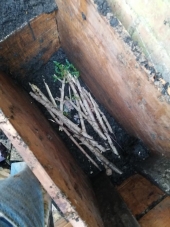Hi folks
I've been idly thinking about installing a fairly small rocket mass heater in the back room of my house, as it's an extension that currently doesn't have any sort of heating. I like the idea of a heated bench, and I was initially thinking of a flue buried in a cob bench, but I've recently come across the bell designs like
this one from SunDogDesigns, and
Batchrocket's one. They seem simpler, but I'm not 100% on the material for the bell (or the "stratification chamber" if you prefer, seeing as it's a long way from being bell-shaped at this point!).
Sundog's bench bell uses an old steel drum that's been cut open and hammered out to a wider radius curve, with cob and adobe laid on top for thermal mass. The side walls are made from cob and adobe, and originally formed part of the structure of a bench with a flue through it. The steel is presumeably to support the cob and adobe and stop the whole thing caving in under the weight of people sitting on the bench. The brick Batchrocket one uses slabs cast from refractory cement to top the bench sections of the bell, and while I may not be as slim as I once was, I doubt I'll put my backside through what's basically a paving slab any time soon, so either of those are viable options.
However, I like the idea of having the thing be at least vaguely portable, in the "take out the thermal mass and it can be moved like you'd move a big oven or other heavy household appliance" sense rather than the "move it routinely as part of day-to-day life" sense. This is both in case I ever move house, and also because I recognise my tinkering and optimising tendencies might mean I decide to rearrange the room sometime in the future. I also have neither a source of free good-quality clay for cob nor any experience laying bricks for something like the batchrocket design. While I'm not averse to buying clay or learning bricklaying if the project calls for it, some things I
do have include a welder, some level of skill with it, and access to a lot of scrap steel box section, as well as probably sheet if I ask the right people. I figure part of permaculture is working with what I can scavenge rather than shipping stuff a long way unnecessarily, so my idea for the overall structure is building a frame out of box section, covering it in sheet steel, and then having something like sand inside for thermal mass.
Where I'm less sure is in terms of the actual stuff in contact with hot gas. I'm aware steel is a biiiiiig no for risers, as the heat of even a fairly modest rocket heater will wreck a steel pipe in fairly short order, so I'll use firebrick or one of the other tried-and-tested methods for that area, but I see plenty of old oil drums used for the bell sections of RMHs in photos. I guess my question is, can I use steel for the bench section of the "bell" too? This might be slightly confusing, so I'll attach a couple of pictures to hopefully explain what I've got in mind. I'd probably go for a similar construction to the outer structure, with a frame made from box section and a sheet steel covering.
Assuming the steel can handle the temperatures in that section of the heater, how well do I need to seal the whole thing if the space around it is filled with sand? As I understand it, flues are under negative pressure due to the motion of the gas, and will therefore usually suck air
in through a small leak, but is going over all the joints with high temp silicone sealant (the stuff for sealing engine exhaust systems) after I weld them a good idea to be on the safe side, or will the sand provide enough of a gas seal that I don't have to worry?
As a footnote on legality, I'm not actually sure if I'd get building regs approval for an RMH in England - if anyone knows any more about that, I'd appreciate the info. If I can't get it approved, I may just use it outdoors as a heated bench.









